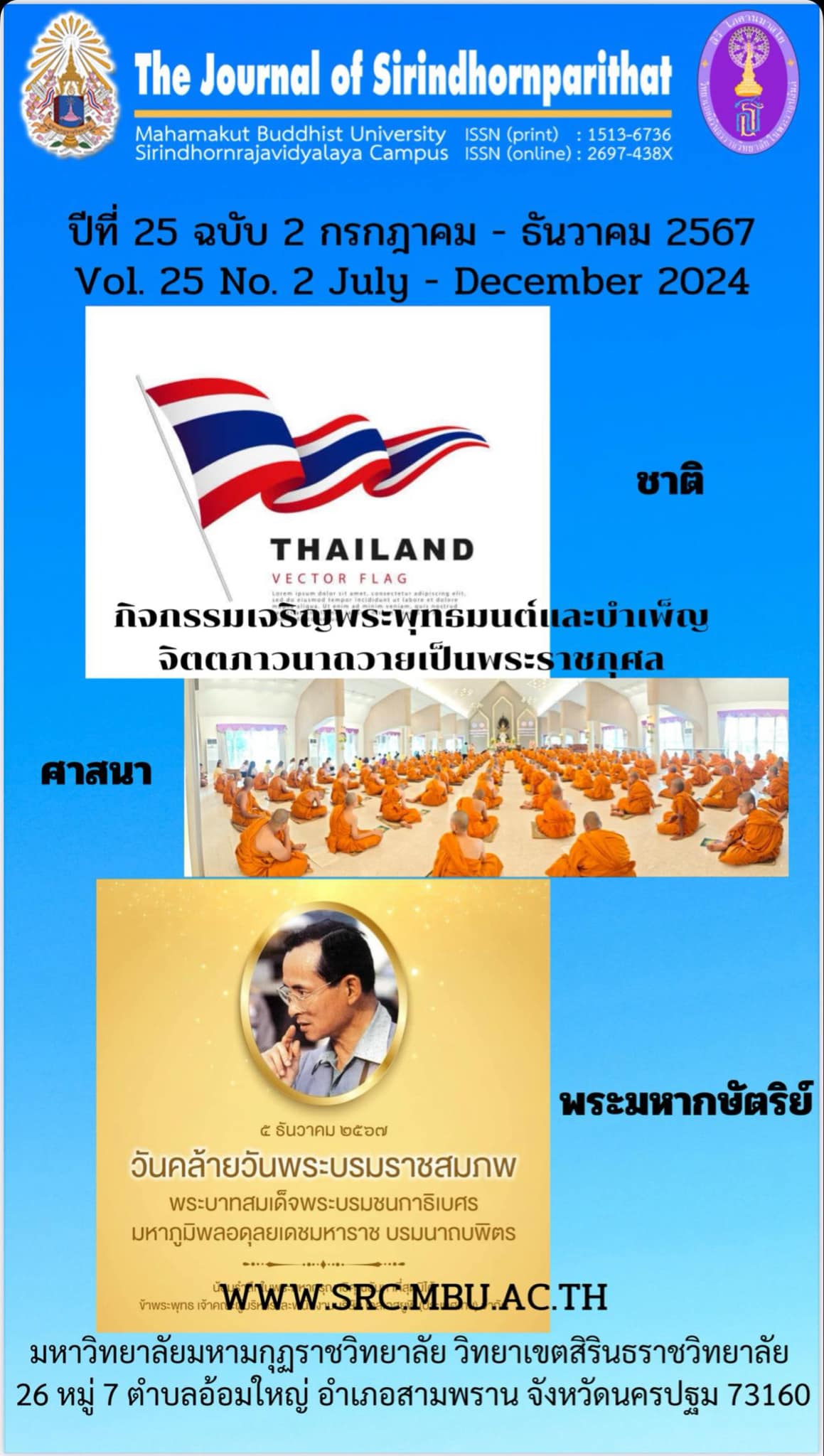Development Of Innovative Thinking Skills Indicators For Secondary School Teachers Under The Office Of The Basic Education Commission In The Central Region : Testing Measurement Invariance By Working Experience
Keywords:
Innovative Thinking Skills, Confirmatory Factor Analysis, Testing Measurement InvarianceAbstract
The objectives of this research were to 1) development of innovative thinking skills indicators for secondary school teachers. 2) to examine the consistency of innovative thinking skills indicators model for teachers with empirical data. 3) test the invariance of the innovative thinking skills indicator model for teachers between different teacher work experiences. The research was carried out in two steps : The first step was to study relevant documents and research to determine the conceptual framework for innovative thinking skills and interview 9 experts. The tool used was a structured interview and data analysis was done through content analysis. Step 2 checking the consistency of the innovative thinking skills model for teachers with empirical data and testing the invariance of the innovative thinking skills indicator model between groups with work experience from 10 years up and a group with less than 10 years of work experience. The sample group was secondary school teachers under the office of the basic education commission in the central region, totaling 810 people from multistage randomization. The data collected by 5 rating scale which was developed in this research. Data were analyzed by using descriptive statistics and reference statistics (mean, S.D., C.V., skewness and kurtosis) and Pearson’s correlation. Second order confirmatory factor analysis and multiple group structural equation model analysis by LISREL.
The result showed as follows
1. Innovative thinking skills for secondary school teachers consists of five components and fifteen indicators; The first element is paying attention consists of observant, see the problem and thinking differently. Component 2 Imaging consists of good communication skills, Complex data management and create a concept.Component 3 Collaborate consists of good communication skills, Complex data management and create a concept. Component 4 Experimenting consists of experimenter, problem solver and knowledge summarization process. Component 5 Elaboration and Association thinking consists of meticulousness, associative skills and ability to interpret.
2.Innovative thinking skills indicator model for teachers founded that the model fit the empirical data (chi-square = 69.611, df = 54, p = .075, GFI = .989, AGFI = .975 RMR = .005, RMSEA = .019) 3. Innovative thinking skills indicator model for teachers there was invariance in the model style between the different groups. But there is variation in the component weights of each indicator.References
เกรียงศักดิ์ เจริญวงศ์ศักดิ์. (2558) เปิดประตูสู่อาเซียนด้วยการคิดเชิงนวัตกรรมอย่างสร้างสรรค์. จุลสาร ป.ป.ช. “สุจริต”. 15(55) : 43-45.
คณะกรรมการกองบริหารงานวิจัยและประกันคุณภาพการศึกษา. (2560). Thailand 4.0 โมเดลขับเคลื่อนประเทศไทยสู่ความมั่งคั่ง มั่นคง และยั่งยืน. กรุงเทพฯ: กองบริหารงานวิจัยและประกันคุณภาพการศึกษา.
จุฑารัตน์ บันดาลสิน. (2557) การพัฒนาความคิดสร้างสรรค์สู่นวัตกรรมการบริการพยาบาล. วารสารพยาบาลทหารบก. 15(3) : 9-17.
ชัยณรงค์ วงศ์ธีรทรัพย์. (2557). ถอดรหัสแนวคิด เพื่อชีวิตที่มีคุณค่า. กรุงเทพฯ: อมรินทร์พริ้นติ้งแอนด์พับลิชชิ่ง.
เนาวนิตย์ สงคราม. (2557) การสร้างนวัตกรรมเปลี่ยนผู้เรียนให้เป็นผู้สร้างนวัตกรรม. กรุงเทพฯ: สำนักพิมพ์จุฬาลงกรณ์มหาวิทยาลัย.
เพลินจิต กิตติยงวิวัฒน์. (2563). การสร้างเครือข่ายการจัดการเรียนรู้สะเต็มศึกษา (STEM) เพื่อพัฒนาทักษะการคิดเชิงนวัตกรรมในโรงเรียนมัธยมศึกษาจังหวัดเพชรบุรี สังกัดสำนักงานเขตพื้นที่การศึกษามัธยมศึกษาเขต 10. วิทยานิพนธ์ครุศาสตรมหาบัณฑิต สาขาวิชาการบริหารการศึกษา คณะครุศาสตร์ มหาวิทยาลัยราชภัฏเพชรบุรี.
วิจารณ์ พานิช. (2555). การศึกษาไทย 2552-2553 สู่เส้นทางแห่งอาจารย์บูชา “ครูเพื่อศิษย์” ส.ค.ส. 2553. กรุงเทพฯ: สถาบันส่งเสริมการจัดการเรียนรู้เพื่อสังคม.
สุกัญญา แช่มช้อย. (2555) แนวคิดเชิงนวัตกรรม สำหรับการบริหารสถานศึกษาในศตวรรษที่ 21. วารสารศึกษาศาสตร์ มหาวิทยาลัยนเรศวร. 4(2) : 117-128.
สุพรรณี อาวรณ์ และแก้วเวียง นำนาผล. (2557) การพัฒนาครูในการจัดการเรียนรู้ด้านการคิดวิเคราะห์โรงเรียนผาน้ำทิพย์วิทยา สำนักงานเขตพื้นที่การศึกษามัธยมศึกษา เขต 27. วารสารบัณฑิตวิทยาลัย พิชญทรรศน์. 9(2) : 56-61.
สำนักงานคณะกรรมการพัฒนาการเศรษฐกิจและสังคมแห่งชาติ. (2558). แผนพัฒนาเศรษฐกิจและสังคมแห่งชาติ ฉบับที่ 12 พ.ศ.2560-2564. กรุงเทพฯ: สำนักนายกรัฐมนตรี.
สำนักงานคณะกรรมการการอาชีวศึกษา. (2562). วิสัยทัศน์ พันธกิจ ของสำนักงานคณะกรรมการอาชีวศึกษา. [ออนไลน์]. สืบค้นเมื่อ 20 กุมภาพันธ์ 2566. เข้าถึงได้จาก http://www.vec.go.th/
สำนักงานเลขาธิการสภาการศึกษา. (2560). แผนการศึกษาชาติ พ.ศ.2560-2579. กรุงเทพฯ: บริษัทพริกหวานกราฟฟิค จำกัด.
Amelink, C., Fowlin, J., & Scales, G. (2013). Defining and Measuring Innovative Thinking Among Engineering Undergraduates. 120thASEE Annual Conference and Exposition,June 22-23 (1-5). Atlanta: American Society for Engineering Education.
Australian Government. (2009). The Australian Government Quality Teacher Programme Strategic Plan 2006-2009. Canberra: Parliament of the Commonwealth of Australia.
Australian National Training Authority (ANTA). (2001). Innovation: Ideas That Work for Trainers of Innovation at Work Skills. Brisbane: Australian National Training Authority.
Ekanem, A. (2018) The Power of Positive, Creative and Innovative Thinking. [Online]. Retrieved June 20, 2021, from https://www.amazon.com/Power-Positive-Creative- Innovative-Thinking/dp/1542667968.
Horth, D., and Buchner, D. (2014). Innovation Leadership: How to use innovation to lead effectively, work collaboratively and drive results. London: Center for Creative Leadership.
Johnston R.E. and Bate J.D. (2013). The power of strategy innovation: A new way of linking creativity and strategic planning to discover great business opportunities. New York: Amacom.
Lee, C., & Benza, R. (2015). Teaching Innovation Skills: Application of Design Thinking in a Graduate Marketing Course. Business Education Innovation Journal 7 (1) : 43-50.
Maxwell, J. C. (2009). How successful people think: Change your thinking, change your life. London: Hachette UK.
Miller, W. C., Couger, J. D. and L.F. Higgins. (1996). Person : Innovation styles profile of IS personnel VS other occupation. Creative lnnovation Management 5 (4) : 226-233.
Miller A. and Dess G.G. (1996). Strategic Management. New York: McGraw-Hill.
Weiss, D. S. and Legrand, C. (2011). Innovative intelligence: The art and practice of leading sustainable innovation in your organization. New York: John Wiley & Sons.
Wheeler, J. (1998). The Power of Innovative Thinking: Let New Ideas Lead You to Success. New York: Career Press Inc.
Downloads
Published
Issue
Section
License
Copyright (c) 2024 Mahamakut Buddhist University

This work is licensed under a Creative Commons Attribution-NonCommercial-NoDerivatives 4.0 International License.
บทความที่ได้รับการตีพิมพ์เป็นลิขสิทธิ์ของ มหาวิทยาลัยมหามกุฏราชวิทยาลัย วิทยาเขตสิรินธรราชวิทยาลัย
ข้อความที่ปรากฏในบทความแต่ละเรื่องในวารสารวิชาการเล่มนี้เป็นความคิดเห็นส่วนตัวของผู้เขียนแต่ละท่านไม่เกี่ยวข้องกับหาวิทยาลัยมหามกุฏราชวิทยาลัย วิทยาเขตสิรินธรราชวิทยาลัย และคณาจารย์ท่านอื่นๆในมหาวิทยาลัยฯ แต่อย่างใด ความรับผิดชอบองค์ประกอบทั้งหมดของบทความแต่ละเรื่องเป็นของผู้เขียนแต่ละท่าน หากมีความผิดพลาดใดๆ ผู้เขียนแต่ละท่านจะรับผิดชอบบทความของตนเองแต่ผู้เดียว




